![]()
![]()
![]()
Use LEFT and RIGHT arrow keys to navigate between flashcards;
Use UP and DOWN arrow keys to flip the card;
H to show hint;
A reads text to speech;
24 Cards in this Set
- Front
- Back
|
Roles of: CDK4 CDK2 CDK1 |

T |
|
|
Cell cycle inhibitors |

|
|
|
ataxia-telangiectasis |

|
|
|
Cell Surface Tumour suppressor genes |
TGF-β receptor Growth inhibition Carcinomas of colon E-cadherin Cell adhesion Carcinoma of stomach (familial) |
|
|
Inner aspect of plasma membrane tumour suppressor genes |
NF1 Inhibition of RAS signaltransduction and of p21cell cycle inhibitor -> Causes Neuroblastomas. Associated with Neurofibromatosis type 1and sarcomas |
|
|
Cytoskeleton tumour suppressor genes |
NF2 Cytoskeletal stability Schwannomas andmeningiomasNeurofi bromastosis type 2,acoustic schwannomas,and meningiomas |
|
|
Cytosol tumour suppressor genes work by? |
Inhibiting signal transduction (from membrane receptor cascading through to nucleus) APC gene -> Familial adenomatous polyposis PI3 transduction pathway -> PTEN gene (prostate + endometrium gene) SMAD2/SMAD4 gene tgf-B pathway; colon pancreas |
|
|
What are the 3 ways that nuclear tumour suppressor genes work? |
Cell cycle regulation: RB1 (retinoblastoma) (when phosphorylated activates transcription of kinases for S phase) p53 P16/INK4a Nuclear transcription WT1 DNA repair BRCA1 and BRCA2 |
|
|
Role of p53 |
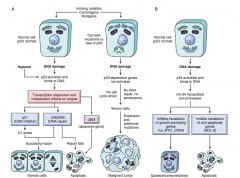
more than 50% of cancers have p53 mutation! |
|
|
Why is angiogenesis so important in tumours? |
Even with all the genetic abnormalities discussed above, solidtumors cannot enlarge beyond 1 to 2 mm in diameter unlessthey are vascularized. L |
|
|
Name the key components of angiogenesis |

|
|
|
- cytokines in chronic inflammation |

|
|
|
Summary of complement |
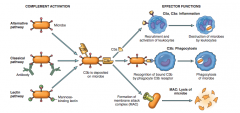
|
|
|
Bradykinin activates which complement? Plasmin activates which complmenet? |
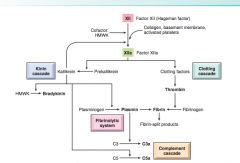
|
|
|
Summaries Growth Factor receptors and pathways |
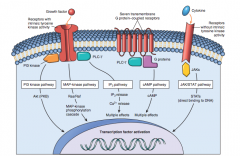
|
|
|
Summarise the extracellular matrix and proteins |
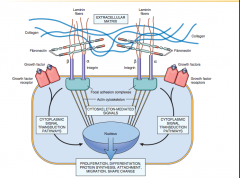
|
|
|
Summarise the vascular endothelial growth factor receptors in angiogenesis |

ang-tie2- stabilisation and periendothelial cell recruitment |
|
|
Summarise wound healing |

|
|
|
Growth factors in wound healing |
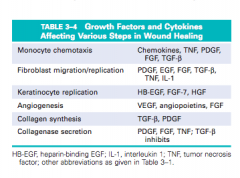
|
|
|
How long does it take for a wound to achieve maximal strength? |

|
|
|
In 24 to 48 hours, spurs of epithelial cells move from thewound edge (initially with little cell proliferation) along the cutmargins of the dermis, depositing basement membrane componentsas they move |
Macrophages stimulate fi broblaststo produce FGF-7 (keratinocyte growth factor) and IL-6, whichenhance keratinocyte migration and proliferation |
|
|
What is the most important fibrogenic agent? |
TGF-b is the mostimportant fi brogenic agent. It is produced bymost of the cells in granulation tissue and causes fibroblastmigration and proliferation, increased synthesis of collagen |
|
|
Neutrophils are replaced by macrophages in ? |
2-3 days of wound healing 48-96 |
|
|
Granulation tissue occurs when in wound healing? What is granulation tissue, and what causes it? |
Fibroblasts and vascularendothelial cells proliferate in the fi rst 24 to 72 hours ofthe repair process to form a specialized type of tissue calledgranulation tissue |

